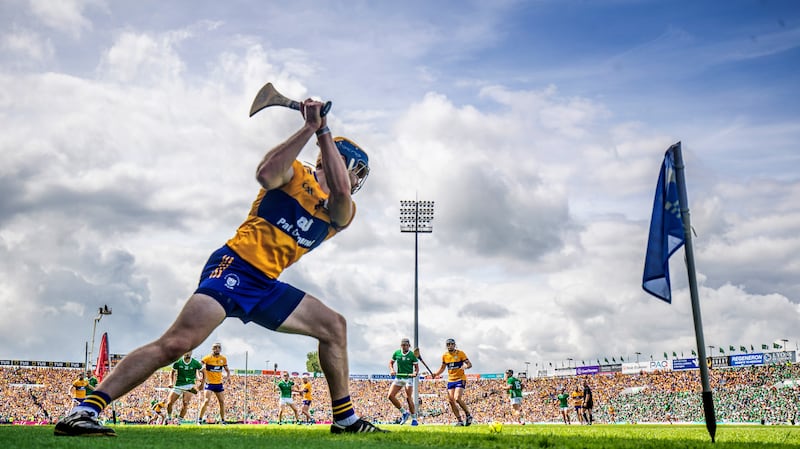The mythologies of Munster were further burnished at the weekend. This was despite the latest episode of Limerick-Clare not generating the hoped-for fireworks of last year’s provincial final in Thurles.
One thing you could depend on though was a tight finish, no matter that it appeared unlikely at times when Limerick looked to be stretching ahead.
Atmosphere is such a big factor, and the TUS Gaelic Grounds baked in the summer heat. It was a gruelling afternoon for such a high-intensity match and it came laden with more records for Limerick, building steadily towards the sort of statistical domination we thought we’d never see again after Kilkenny.
This year to date has seen the champions move into their “resilient” period, that knack of being in front at the final whistle, almost regardless of how the match has progressed and in contrast to the “domination” period, during which they racked up three-in-a-row All-Irelands.
READ MORE

Even last year with narrow margins in the All-Ireland series, the championship was achieved by Limerick without two important players and also in the reality that they didn’t look like losing either the semi-final or final.
The ambient notion that Munster hurling is keeping the GAA afloat at a time of structural nihilism and creative bankruptcy in the football championship may be true at present, but it’s as well not to take these things for granted.
A functioning five- or six-county round-robin needs at least three teams to be competitive. This year in Munster there were four, and with a winning margin in matches against each other averaging just a point and a half, it was axiomatic that the fourth team – in this case Cork – would be desperately unlucky.
When questioned about the universal benefits of having four weeks’ break before the All-Ireland semi-final, Limerick captain Declan Hannon artfully referred to the old lament that Munster champions went into semi-finals with the burden of inactivity against teams sharpened by quarter-final combat.
Yet it is possible to hold the two thoughts in your head at the same time. For inexperienced or unpractised teams – which Munster champions often were – the four-week break was a hindrance, but for Kilkenny in their pomp, it was built into the year’s routine.
Out of the 17 years they won Leinster, Brian Cody’s team lost just four All-Ireland semi-finals.
On Sunday, Limerick manager John Kiely welcomed the break without reservation.
“We managed the four weeks last year. We’ve done it in the past. We know our routine – it’s nailed down,” Kiely said.
“Everybody knows what to expect before I say it. They know exactly what is going to happen this week, the week after, the week after that and the subsequent week.”
There is another difference between then and now. Not alone are Limerick champions for the fifth time but the round-robin has changed the dynamics of the season.
From the start of the format in 2018, it was clear that weekly matches made severe demands on players, and schedules had to be tweaked to prevent counties having to play too many matches in a short space of time.
[ Clare can find solace in defeat, as the numbers don’t add up for LimerickOpens in new window ]
Clare were victims last year of exhausting themselves in Munster final extra-time and being thoroughly debilitated when it came to the All-Ireland series with an additional match for provincial runners-up.
This overall situation has raised concerns that Munster teams have to expend larger amounts of energy in getting out of the province compared with their Leinster counterparts.
It’s undeniable. This year, neither Galway nor Kilkenny had an anxious moment about qualification for the All-Ireland series. Dublin could have put Galway out of the final but didn’t quite manage it.
Would it be fairer for Munster teams if the round-robin groups mixed according to seeding? Of course, but then we would end up with two identical league competitions, one after the other.

There is another compelling reason why it won’t happen. Munster have had a fantastic year at the box office. In his welcoming address for Sunday’s programme, provincial chair Ger Ryan pinpointed the reason why Munster hurling is unlikely to be tampered with.
“We have had great crowds at our games this year and by throw-in time today, total attendances of this year’s senior hurling championship will exceed 300,000,” Ryan said.
That adds up to a staggering average attendance of 27,288 per match. When you consider the misgivings – justified in the football championship – about the round-robin format and its traditional impact on attendances, that’s an astonishing figure, especially as it includes Waterford’s doomed fixture list.
It means the average crowd in Munster was nearly 3,000 greater than the Leinster final, which was itself the best attended match in the province by a distance.

Like all formats, however, the Munster round-robin is only as good as the teams competing. Four years ago, Leinster had the most memorable finale of any round-robin season with four teams in with a shout all evening for three places.
Since then, Wexford have begun to tread water and Dublin are rebuilding, leaving little jeopardy. With Waterford falling back, it only takes another county to drop off the pace and suddenly Munster isn’t so exciting.
Like all golden ages, Munster’s current popularity coincides with one of the traditionally less powerful counties in the ascendant. It may be that Limerick use their unprecedented success to step up to that level on a permanent basis. Time will tell.
For now, it’s great to bask in the thunderous acclaim for such a wonderful season but it’s worth bearing in mind that there are no sure-fire formats in the GAA championship – just ones that suit the circumstances of a given time.


















